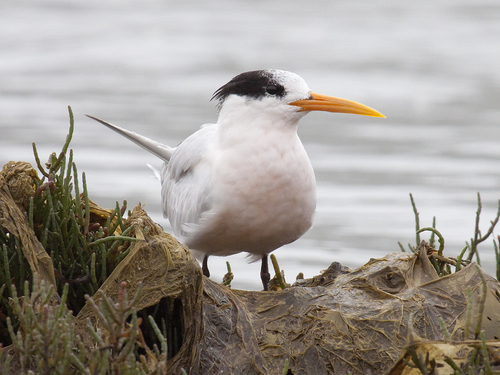
Elegant Tern
The Elegant Tern (*Thalasseus elegans*) is a medium-sized seabird known for its slender build, striking orange-red bill, and shaggy black crest. It plays a crucial role in coastal ecosystems as a predator of small fish, contributing to the balance of marine food webs. While not holding specific cultural significance in many areas, its beauty and graceful flight are admired by birdwatchers along its limited range. Its breeding colonies are spectacles of concentrated activity, vital for the species' survival.
39-43 cm
Length
85-95 cm
Wingspan
Near Threatened
Conservation Status
Distribution
The Elegant Tern has a relatively restricted range, primarily breeding on islands off the coast of Baja California, Mexico, particularly Isla Rasa. Non-breeding birds disperse along the Pacific coast of North and South America, from southern California to Chile and Peru. They rarely venture far inland.
Lifespan
Up to 15 years in the wild, though the average is likely lower.
Elegant Tern's Habitat
Habitat Types
Coastal waters, Estuaries, Sandy beaches, Rocky shores
Climate Zones
Subtropical, Temperate
Adaptations
Elegant Terns possess streamlined bodies and long, pointed wings adapted for efficient flight over water. Their sharp bills are well-suited for catching small fish near the surface. They also have salt glands, common in seabirds, to excrete excess salt ingested with seawater.
Variations
No recognized subspecies exist; however, some variations in plumage brightness may occur between different breeding colonies.
Appearance
Breeding Plumage
Breeding adults have a black cap that extends to a shaggy crest, white underparts, and pale gray upperparts. Non-breeding adults have a white forehead, and the black cap becomes less defined. The bill color can fade slightly outside of the breeding season.
Seasonal Feather Changes
The most significant seasonal change is the development of the full black cap and crest during the breeding season.
Sex Based Plumage Differences
Males and females have very similar plumage.
Notable Features
Long, slender, orange-red bill., Shaggy black crest during breeding season., Long, pointed wings., Forked tail.
Diet and Feeding
Primary Foods
Small fish (e.g., anchovies, sardines), Crustaceans (occasionally)
Foraging Behavior
Elegant Terns primarily feed by plunge-diving. They fly over the water, hover briefly, and then dive headfirst to capture prey near the surface. They may also dip to the surface while in flight.
Specializations
Their slender, pointed bill is perfectly adapted for seizing small, slippery fish.
Seasonal Diet Variations
Diet varies depending on the availability of prey. During the breeding season, they rely heavily on schooling fish that congregate near their nesting colonies. During migration and in wintering areas, they may take a wider variety of fish species.
Behavior
Social Structure
Highly social, especially during the breeding season, when they form dense colonies. Outside of breeding, they often forage in flocks.
Communication
Loud, grating calls., Visual displays, including head-bobbing and crest-raising.
Migration
Elegant Terns undertake extensive migrations along the Pacific coast of the Americas. Northern populations move south after breeding, while some birds from Baja California may move north.
Territorial or Group Behaviors
Within breeding colonies, they defend a small area immediately around their nest. They are not strongly territorial outside of the breeding season.
Conservation
Threats
Habitat disturbance (especially at breeding colonies), Overfishing of prey species, Climate change (affecting sea temperatures and prey availability), Pollution (including plastic ingestion), Egg harvesting (historical threat, now largely controlled)
Protection Programs
Protection of Isla Rasa as a wildlife sanctuary, Monitoring of breeding colonies, International cooperation to manage fisheries and reduce pollution
Local National Laws
Protected under Mexican law. Also protected under the Migratory Bird Treaty Act in the United States.
Population Trend
Fluctuating, but generally considered to be declining.
Population Estimates
Estimated global population is around 100,000-150,000 individuals, with the majority breeding on Isla Rasa.
Interesting Facts
Isla Rasa, the primary breeding site, hosts over 90% of the world's Elegant Tern population.
This makes the species highly vulnerable to localized threats affecting this single island.
Elegant Terns can sometimes be seen associating with other seabird species, such as Royal Terns.
They may forage together or share resting areas.
They are known for their agile flight and precise diving skills.
These adaptations are crucial for catching fast-moving fish in the open ocean.
Faqs about Elegant Tern
What is the biggest threat to Elegant Terns?
The biggest threat is disturbance and degradation of their breeding colonies, particularly on Isla Rasa. Overfishing and climate change are also significant concerns.
How can I tell an Elegant Tern from a Royal Tern?
Elegant Terns are slightly smaller and more slender than Royal Terns. The Elegant Tern's bill is thinner, longer, and more orange-red, while the Royal Tern's bill is thicker and more orange. The Elegant Tern's crest is also typically shaggier.
Do Elegant Terns mate for life?
While they form strong pair bonds during the breeding season, it's not fully understood if they mate for life. More research is needed on their long-term pair fidelity.
Copyright @ Nature Style Limited. All Rights Reserved.
 English
English